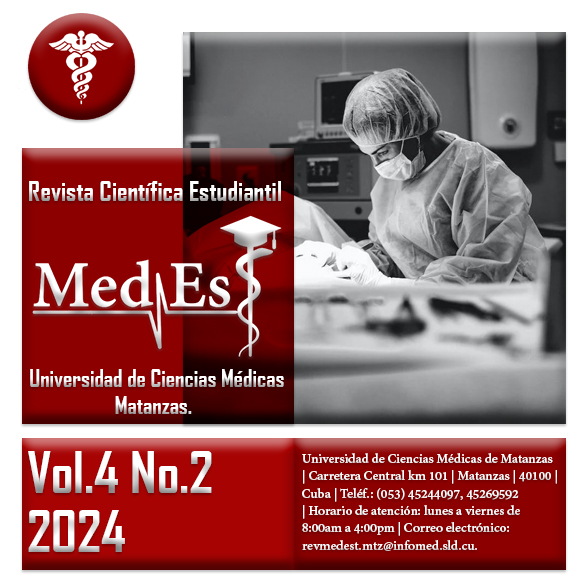Interdisciplinarity in the training of medical students
Keywords:
Medical Education, Students, Interdisciplinarity, Medicine, Teaching-learning process, HealthAbstract
The defense of interdisciplinarity has an increasing significance in educational dynamics, where several disciplines share an object of study, as well as approach or research methodologies, managing to communicate and coordinate in a field of knowledge. In addition, the emergence of interdisciplinary research teams is observed in institutes, centers and foundations where several fields of knowledge and research converge, to understand and solve complex problems. Interdisciplinarity constitutes the process of "enrichment" of the curriculum and learning of its actors that is achieved as a result of recognizing and developing the existing links between the different disciplines of a study plan through the components of the didactic systems of each of them. The relationships in the training of general physicians of the interdisciplinary nodes were reflected upon, due to their contribution to the comprehensive training of the graduate. Plan E has curricular adjustments and proposes improvements for the teaching-learning process that are proportional to the requirements of the health system and scientific development in the 21st century. In the training of the future Cuban medical professional, attention is paid to the process of interdisciplinarity in the various training disciplines that are conceived within the curricular design of the career, through lines or strategies that allow the incorporation of skills and new knowledge to the future professional.Downloads
References
2. Valcárcel Izquierdo N. La Educación Médica: origen y evolución como ciencia. Rev Cub Tecnol Salud [Internet]. 2019 [citado 12/02/2024]; 10(1). Disponible en: https://revtecnologia.sld.cu/index.php/tec/article/view/1428
3. Pérez RM, Martí Núñez AE, Paneque Ginart AN, Hernández Casas JJ, Rodriguez Diaz CR, Llosa Santana M. Fundamentos de la estrategia educativa para el fortalecimiento de la identidad cultural cubana en el desempeño docente. Rev Cub Tecnol Salud [Internet]. 2020 [citado 12/02/2024]; 11(2). Disponible en: https://revtecnologia.sld.cu/index.php/tec/article/view/1693
4. Baute Plana A. Propuesta metodológica con enfoque interdisciplinario y desarrollador para la Formación Ciudadana de estudiantes de Enfermería. Rev cuba educ super [Internet]. 2023 [citado 12/02/2024]; 42(3):256-67. Disponible en: https://revistas.uh.cu/rces/article/view/7925
5. Rodríguez González J, Suárez Cabrera A, Valcárcel Izquierdo N, Alea González M, Lago Queija M. El enfoque interdisciplinario en la disciplina principal integradora medicinageneral. Algunas reflexiones Invest. Medicoquir [Internet]. 2020 [citado 12/02/2024]; 12 (2). Disponible en: https://www.medigraphic.com/pdfs/invmed/cmq-2020/cmq202t.pdf
6. González Betancourt E. La interdisciplinariedad en la superación del médico de familia para la prevención de enfermedades profesionales. Tesis presentada en opción al grado científico de Doctor en Ciencias de la Educación. Universidad de Matanzas. 2023. Disponible en: https://rein.umcc.cu/handle/123456789/2190
7. Cerini A. Mirada interdisciplinaria, un enfoque interesante a desarrollar. Paraná. Argentina [Internet] 2019 [Citado 12/02/2024]. [aprox. 5 p.]. Disponible en: http://formacionib.org/noticias/?Mirada-Interdisciplinaria-un-enfoque-interesante-a-desarrollar
8. González García TR. La interdisciplinariedad: un reto para la universidad actual. Rev. Cub. Tecnol. Salud. [Internet]. 2017 [citado 12/02/2024]; 8(1). Disponible en: https://revtecnologia.sld.cu/index.php/tec/article/view/879
9. Garriga Dueñas A, Díaz Alvarez L, Ferro González B, Coniel Linares E, Vives Medina O, Santana Martínez R. Las relaciones interdisciplinarias: un reto para los docentes en la carrera de Medicina. Revista de Ciencias Médicas de Pinar del Río [Internet]. 2021 [citado 12/02/2024]; 25(5): [aprox. 0 p.]. Disponible en: https://revcmpinar.sld.cu/index.php/publicaciones/article/view/5118
10. Alonso Gómez M, Estrada Rodríguez Y, Cardero Garcés V, Naranjo Lima S. El estudio de la Historia de Cuba en la carrera de Medicina desde concepciones martianas. Revista MedEst [Internet]. 2023 [citado 12/02/2024]; 3 (3) Disponible en: https://revmedest.sld.cu/index.php/medest/article/view/179
11. Hernández Rincón EH, Acevedo Giedelman P, Ávila Celis P, Sánchez Vergara JF, Quiroga Carillo M. La salud pública como pilar para la educación de los profesionales de salud en Colombia. Educ médica Super [Internet]. 2020 [citado 12/02/2024]; 34(1):e1674. Disponible en: http://scielo.sld.cu/scielo.php?script=sci_arttext&pid=S0864-21412020000100013
12. Fajardo Dolci G, Santacruz Varela J, Contrera Toro IF, Yorio Nieto MA, Pichs García LA, Zambrana Ávila GW, et al. Formación de médicos generales en América Latina: un reto para la salud universal. Rev Panam Salud Pública. [Internet] 2019 [citado 12/02/2024]; 43:e83. Disponible en: https://iris.paho.org/handle/10665.2/51646
13. Bosch Nuñez AI. Fundamentos teóricos de una estrategia didáctica interdisciplinaria entre la Farmacología y las asignaturas clínicas estomatológicas en la Universidad de Ciencias Médicas de Santiago de Cuba. Acta Odont Col [Internet] 2022 [citado 12/02/2024]; 12(2):105–114. Disponible en: https://doi.org/10.15446/aoc.v12n2.98715
14. Mirabal Nápoles M, Llanes Mesa Ll, Cadenas Freixas JL, Carvajal Hernández B, Betancourt Valladares M. Interdisciplinariedad e investigación formativa desde la asignatura Célula, tejidos y sistema tegumentario. Medisur [Internet]. 2020 [citado 12/02/2024]; 18(4):639–649. Disponible en: http://www.medisur.sld.cu/index.php/medisur/article/view/4507/3216
15. De la Tejera Chillón N, Cortés Sendón C, Viñet Espinosa LM, Pavón De la Tejera I, De la Tejera Chillón A. La interdisciplinariedad en el contexto universitario. Rev Pan Cub y Sal [Internet]. 2019 [citado 12/02/2024]; 14(1):58–61. Disponible en: http://www.revpanorama.sld.cu/index.php/panorama/article/view/1193/pdf_329
Downloads
Published
How to Cite
Issue
Section
License
Those authors who have publications with this journal accept the following terms: The authors will retain their copyright and guarantee the journal the right of first publication of their work, which will be simultaneously subject to the Recognition License. Creative Commons that allows third parties to share the work as long as its author and its first publication in this magazine are indicated. Authors may adopt other non-exclusive license agreements for the distribution of the published version of the work (e.g.: deposit it in an institutional telematic archive or publish it in a monographic volume) as long as the initial publication in this journal is indicated. Authors are allowed and recommended to disseminate their work through the Internet (e.g.: in institutional telematic archives or on your website) before and during the submission process, which can produce interesting exchanges and increase citations of the published work.





